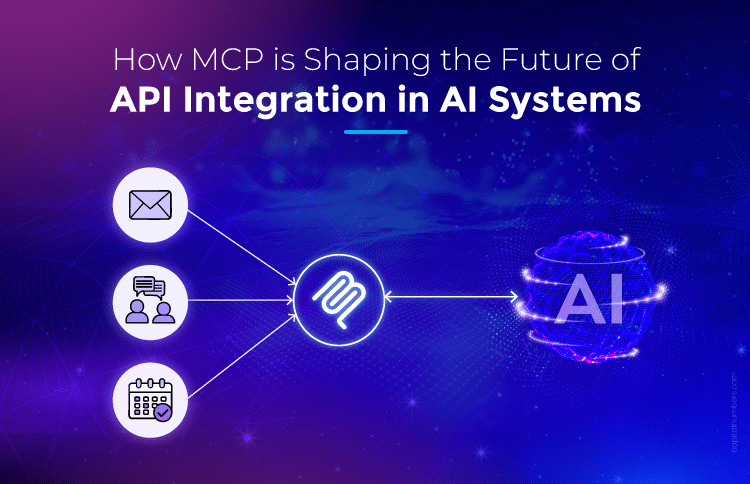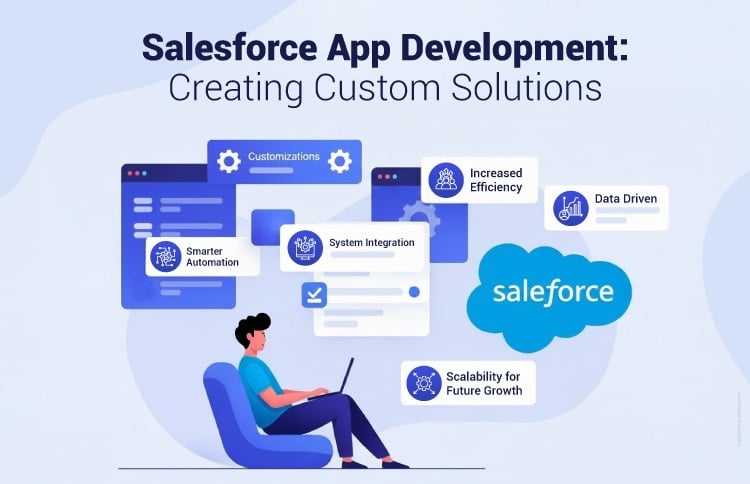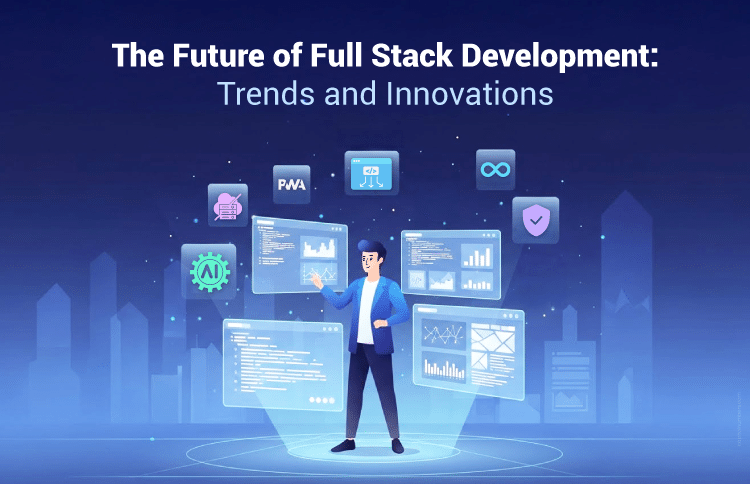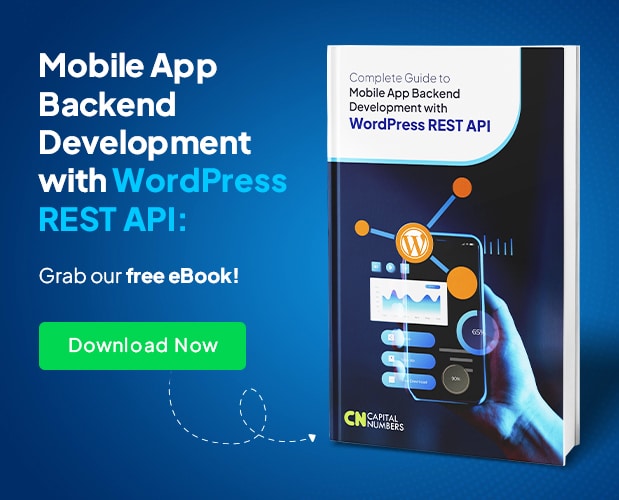How MCP is Shaping the Future of API Integration in AI Systems
Table of Contents
Think back to when connecting a new device to your computer meant dealing with different cables and complicated drivers. The AI world is facing a similar problem today. Large Language Models (LLMs) are great at processing information, but when it comes to interacting with the real world – like checking a calendar or sending an email – they often rely on clunky, fragile, and one-off API connections.
That’s where a major change is happening. The Model Context Protocol (MCP) is doing for AI what the USB-C port did for hardware – creating a single, universal standard. MCP isn’t just another API. It’s an open framework that lets AI systems easily find, understand, and work with a wide range of external tools and data sources.
Instead of building countless one-to-one integrations, MCP enables a simple, plug-and-play approach. This could spark a new era of AI agents that are truly autonomous and context-aware.
In this blog, we’ll break down what MCP is, why it’s such a big step forward, and how it’s set to transform software development in the AI era.
What is MCP?
The Model Context Protocol (MCP) is an open, standardized protocol created to enable AI systems, including large language models (LLMs), computer vision models, and other AI applications, to securely and efficiently interact with external tools, data sources, and services. Rather than a standalone software product, MCP defines a common language and set of communication rules that AI clients (such as chatbots or agents) use to exchange context, validate data, and invoke external functions via MCP servers.
Developed by Anthropic, MCP uses the JSON-RPC 2.0 protocol to structure robust client-server communications. AI models act as clients that request and receive context and capabilities from MCP servers, which expose external resources like databases, APIs, or computation tools. This approach allows AI applications to extend their reasoning beyond initial training by dynamically accessing real-world, up-to-date information.
Key Concepts Enabled by MCP
- Context Management Layer
This layer ensures the AI receives the correct context before making decisions, such as previous data, user input, or external factors. It helps the AI understand the data in a relevant, accurate manner by focusing on the most important data points. For instance, when AI interacts with multiple data sources, this layer ensures only the most relevant context is applied, optimizing performance. - API and Interoperability Framework
MCP simplifies communication between various systems by using a standardized approach. AI models can easily integrate with tools, services, and databases, providing them with the correct context. This interoperability supports a wide range of platforms, such as TensorFlow and PyTorch, making it easier for AI systems to exchange data across different environments. - Dynamic Context Delivery
This approach helps an AI get the right information at the right time. Instead of giving the AI everything, it uses Adaptive Context Injection (ACI) to pick out only the most important details. For example, a customer service bot would only see a customer’s past messages, not all other data. This makes the AI smarter and more efficient. It also helps the AI avoid getting confused by too much information. - Security and Compliance
MCP ensures that data is transmitted securely by using strong encryption protocols like TLS (Transport Layer Security). It also follows industry-standard data privacy regulations, including GDPR and CCPA, ensuring that sensitive data is handled securely. For instance, in a healthcare application, MCP guarantees that patient data is securely shared and only accessible by authorized systems. - Client-Server Architecture
MCP uses a client-server setup where the AI model (client) communicates with external services (servers) via a standardized protocol. This architecture makes it easy to integrate new tools and services as your system grows, ensuring smooth communication between the AI and external data sources without requiring major reconfigurations.
What Are the Benefits of MCP?
- Smarter Decisions:
By giving the AI the right context, MCP helps it make decisions that are more accurate and relevant. It’s like giving the AI more “knowledge” to work with, leading to better results. - Fewer Mistakes:
Without proper context, AI can make errors. MCP reduces these by ensuring the AI gets the full picture before it acts, thereby improving reliability. - Faster and More Efficient:
MCP helps AI process data faster by focusing only on what’s important. This makes everything run smoother, using less power and delivering results quickly. - Easier Collaboration:
MCP ensures that different systems can work together smoothly. By using a standard approach, AI models can communicate with other platforms and tools without losing context. - Scalability:
As your AI systems grow, MCP makes it easy to add new features and tools without disrupting things. It’s flexible, so your system can expand as needed. - Security:
With built-in encryption and privacy features, MCP ensures that your data is safe when it’s shared across systems. You can trust that everything stays secure, which is especially important if you’re dealing with sensitive information.
Need seamless API integration to enhance your AI systems?
At Capital Numbers, we simplify API solutions, whether custom or improving existing ones, to make your AI smarter and faster. Contact us to learn how our API development and integration services can drive your business growth.
How Does MCP Address API Limitations for AI?
If you’ve worked with AI systems, you know how tricky API integration can be. Traditional APIs often send data without its full context, leading to mistakes and confusion for the AI. The Model Context Protocol (MCP) solves this problem by ensuring that APIs and AI models exchange data with the right context, helping the system make better, more reliable decisions. Think of it like giving the AI all the important details it needs to understand the data, which significantly improves AI system integration.
Examples of How MCP Solves API Limitations
- Contextual Mismatches:
Have you ever seen data that doesn’t make sense because it’s missing crucial information? This happens with traditional APIs when they send data without a clear background. The AI system might get confused, leading to errors.MCP fixes this by ensuring the data comes with the right context. For example, an AI might receive a data point “temperature is 98.6°F.” Without context, it could be considered that this is an environmental reading. MCP ensures the data includes the context that it’s from a “human patient” and is a “body temperature reading,” preventing the AI from misinterpreting it.
- Static Interactions:
Traditional APIs can be slow to adapt when data changes. If new information comes in, they may not update quickly enough, causing delays or mistakes.MCP makes things more flexible. It ensures that even when data changes in real time, the AI system can still apply the right context and keep everything running smoothly. This is crucial for applications that rely on live data, such as a stock trading bot or a traffic management system, where information is constantly changing.
- Data Formatting Issues:
Data often comes in different formats, which can be a problem when different systems use different styles. This mismatch can confuse the AI or waste time trying to convert it.MCP helps by making sure the data is in the right format. The protocol’s standardized framework reduces the need for complex, one-off data converters. By defining a common language, MCP ensures that data from different sources is consistently formatted and delivered to the AI, streamlining the process and making AI interoperability seamless.
Traditional AI Approach vs. MCP Approach
Traditional AI systems often rely on static data transfers and lack context, which can cause errors and inefficiencies. They struggle with mismatched data formats and updates in real time. In contrast, MCP ensures that data always comes with the right context, helping AI models make better decisions. By improving AI integration and interoperability, MCP enables AI systems to perform more efficiently, even when dealing with multiple data sources or changing APIs.
Let’s check the comparison below.
| Aspect | Traditional AI Approach | MCP Approach |
|---|---|---|
| Data Handling | Static data transfer with no context | Context-aware data exchange with real-time updates |
| Data Interpretation | Misinterpretation of data | Better understanding with relevant context |
| Real-time Awareness | Struggles with real-time data and context shifts | Always up-to-date, adapts quickly to new inputs |
| API Integration | Difficulty managing evolving APIs | Seamless handling of dynamic APIs |
| Error Reduction | Higher chances of errors due to a lack of context | Reduced errors through context-based decision-making |
| Scalability | Limited flexibility when scaling | Scalable and adaptable to new technologies |
How to Get Started with MCP?
Adopting Model Context Protocol (MCP) in your existing AI systems might seem like a big step, but it’s easier than it sounds. Here’s a simple guide to help you get started.
Key Steps for Implementation
- Define the Context Protocols:
First, decide what kind of context your AI needs to use. It could be past data, real-time information, or external factors. This helps your AI understand the data better and make more accurate decisions. - Choose Tools that Support Context-Driven API Calls:
Pick the right tools and frameworks that support context-aware data exchanges. You’ll need platforms that allow your APIs to pass data with the correct context, helping your AI process it more effectively. - Scale and Test the Integration:
After defining the context and choosing the tools, start integrating MCP into your system. Begin by testing it in a small environment to ensure it works well. Verify that the AI processes data with the correct context and assess its performance with various data sources.
Tools and Technologies
To make MCP work smoothly, you need the right tools for AI system integration and AI interoperability. Here are some options:
- Open-Source Libraries:
Libraries like LangChain or Haystack are great for building context-aware applications and can help you integrate MCP into your AI systems. - MCP Software Development Kits (SDKs):
The official MCP SDKs (available for languages like Python, TypeScript, and others) are the core tools for building compliant clients and servers. You can use these SDKs to create applications that integrate with powerful AI frameworks like TensorFlow, PyTorch, or the OpenAI API. - API Integration Platforms:
Platforms like Postman or Zapier can help streamline the process. Postman’s AI Agent Builder, for instance, is designed to help you create and test MCP servers. Zapier can be used to build automated workflows that interact with MCP-enabled systems, making it easier to connect with multiple data sources.
Transforming Elderly Healthcare with Predictive AI Solutions
Discover how we implemented predictive AI solutions to enhance elderly healthcare services. [Read the case study here!]
Who’s Leading MCP Server Development in 2025?
In 2025, several companies are leading the way in MCP server development, making it easier for AI models to connect with external tools and data sources. These companies are improving AI system integration and AI interoperability, making it easier for AI systems to share context and communicate with other platforms.
Major Cloud Providers
- Amazon Web Services (AWS):
AWS is a key player with its AWS Data Processing MCP Server. This open-source tool simplifies analytics and ETL processes for AI assistants, allowing AI models to interact with AWS services like Glue, EMR, and Athena through natural language commands. - Google Cloud:
Google Cloud is advancing MCP adoption with the Firebase MCP server, which allows AI-powered development tools to work directly with Firebase projects. This server enables AI clients to manage data and resources in Firebase using standard protocol commands. - Microsoft Azure:
Microsoft is leading with its Azure MCP Server. This server enables AI agents to interact with Azure resources through natural language, using Microsoft’s developer tools and authentication best practices. It allows AI clients like GitHub Copilot to connect and manage Azure resources.
AI Companies and Platforms
- Anthropic:
As the creator of the Model Context Protocol, Anthropic continues to be a major leader. Its Claude Code client can connect to remote MCP servers, ensuring secure, two-way connections that provide real-time access to relevant context for better decision-making. - SuperAGI:
SuperAGI focuses on providing MCP server solutions to improve the development, deployment, and management of AI models. It is a significant player in the AI agent ecosystem that leverages MCP to build more efficient and scalable systems. - OpenAI:
OpenAI is a key enabler of the MCP ecosystem. While they are not focused on developing their own MCP servers, they provide documentation and tools that allow developers to build and integrate MCP servers with their platform, enabling their models to access tools and external data sources.
Infrastructure and Tooling Providers
- Cloudflare:
Cloudflare is a leader in providing the infrastructure for MCP servers. It offers tools for deploying and scaling these servers, notably through its Durable Objects, which enable the creation of stateful, persistent AI agents on its global network. - Sentry:
Sentry has developed its own Sentry MCP Server, which allows AI tools to securely access error and performance data. This server can be integrated with development environments like Visual Studio Code, providing AI agents with real-time observability data to help with debugging and issue resolution. - Digma AI:
Digma AI provides an MCP server that leverages its dynamic code analysis engine. This server enriches AI agents with deep runtime context by analyzing APM data, enabling them to provide safer, more performant, and context-aware code suggestions and reviews.
Popular Use Cases of MCP in AI API Integration
MCP is used in many ways to help AI systems work better with external tools and services. Here are some popular use cases where MCP is making a difference:
Adaptive Trading Bots
MCP helps trading bots connect to new data sources and market endpoints from different exchanges. This allows them to quickly adapt to market changes and deploy new strategies, giving traders an advantage in fast-moving markets.
Agent-Driven Market Analytics
AI agents use MCP to pull real-time data, such as order books and market information, directly, without the need for manual API mapping. This ensures AI systems can provide up-to-date insights automatically, improving decision-making in the financial sector.
Automated Cloud Resource Management
MCP enables AI agents to manage cloud resources, configurations, and security automatically. By connecting to cloud platforms like AWS, Azure, or Google Cloud it reduces manual tasks and helps manage cloud environments more efficiently.
Automated Web Browsing and Interaction
With MCP, AI agents can navigate websites, fill out forms, and extract data without human input. This is done through tools like Puppeteer or Playwright, making it easier to automate tasks like web scraping and testing.
Dynamic Tool Invocation
MCP allows AI models to call external tools and services on demand. Whether it’s searching customer data, generating reports, or performing calculations, this flexibility means AI can handle a variety of tasks without needing everything pre-programmed.
Emerging Trends of MCP in AI API Integration
As more industries adopt AI, MCP will be at the core of making systems more connected, flexible, and efficient. Here are some of the key trends shaping its future in AI API integration.
AI Agent Workflows:
In the future, MCP servers will play a crucial role in enabling AI agents to connect with various tools and platforms. This will allow AI to automate tasks and work more independently, making smarter decisions without constant human input.
Interoperability and Integration:
As more AI systems are developed, MCP will make it easier for different AI models and tools to work together. This will simplify integration, helping systems communicate smoothly and efficiently, no matter how complex they are.
Security and Compliance:
Moving forward, security and compliance will be top priorities for organizations using MCP servers. With more AI applications handling sensitive data, ensuring secure, compliant connections will be crucial, especially for mission-critical systems.
Real-Time Data and Dynamic Task Flows:
MCP servers will enable AI systems to access real-time data and manage tasks on the fly. This means AI will be able to respond instantly to new information, making decisions faster and more accurately, regardless of how rapidly the data changes.
You May Also Read: AI Agents vs Agentic AI: Key Differences Explained
Final Words
After going through the details, you can understand how MCP is changing the way AI systems work. It makes AI smarter and more reliable by ensuring data is always shared with the right context. This helps AI models communicate better, adapt faster, and make more accurate decisions.
Why Choose Capital Numbers for Custom AI Software Development?
At Capital Numbers, we specialize in custom AI software development. Our solutions are designed to seamlessly integrate with your existing tools and deliver real, impactful results.
- End-to-End Solutions
- Tailored Solutions to Fit Your Business Needs
- Post-Launch Support
Want to discuss your project needs? Schedule a free consultation today!


















